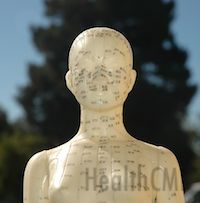New research finds acupuncture effective in reducing malignant bone cancer tumor growth when applied in early stages.  Acupuncture was also shown to reduce lung metastasis when applied in an early stage of development. The University of Minnesota and Medical College of Wisconsin researchers suggest that the ability of acupuncture to reduce bone tumor growth and lung metastasis may be related to its ability to reduce tumor associated inflammation.
Acupuncture was also shown to reduce lung metastasis when applied in an early stage of development. The University of Minnesota and Medical College of Wisconsin researchers suggest that the ability of acupuncture to reduce bone tumor growth and lung metastasis may be related to its ability to reduce tumor associated inflammation.
The investigators studied the effects of acupuncture on osteosarcoma, a highly malignant form of bone cancer. Electroacupuncture was applied to laboratory mice with osteosarcoma at acupuncture point ST36, Zusanli. The investigators became interested in this research, in part, as a result of other research demonstrating acupuncture’s regulatory effects on angiogenesis, the development of new blood vessels. The investigators note that this regulatory effect may “alter tumor vasculature” thereby affecting “tumor progression and metastasis.”
The investigators began with an initial hypothesis that low frequency electroacupuncture has anti-tumor and anti-metastatic effects achieved by regulating tumor related vasculature, lymphatics and nerve innervation densities. True acupuncture and sham acupuncture were compared in the laboratory study. For both the true and sham acupuncture investigations, SEIRIN intradermal stainless steel acupuncture needles were used to a depth of 3mm. The true acupuncture group received acupuncture at ST36 with electroacupuncture. The sham group received acupuncture at ST36 with no electrical stimulation. The control group did not receive either sham or true acupuncture. The researchers chose acupuncture point ST36 for the study based on prior research demonstrating its ability to treat cancer related pain and inflammatory pain. Electroacupuncture was applied at 4HZ with a 100 microsecond pulse width for 30 minutes for each acupuncture session.
The results of acupuncture on tumor growth varied dependent upon when the acupuncture treatments were initiated. Model mice were implanted with osteosarcoma cells. In the study, the electroacupuncture began at post-implantation day 3 (PID3) in group 1, post-implantation day 5 (PID5) in group 2 and post-implantation day 7 (PID7) in group 3. There were also differences in results based on whether acupuncture was applied once per week or twice per week.
The researchers noted numerous studies providing evidence that acupuncture can down-regulate pain, reduce nausea and vomiting and reduce fatigue. They cited only one case report showing that acupuncture reduces tumor growth in which acupuncture caused regression of human ductal carcinoma. They noted no prior acupuncture research on tumor metastasis and potential sex differences related to patient outcomes.
Although acupuncture is able to reduce tumor related pain as early as post-implantation day 3, no mice in the study showed effects on tumor growth within the first 10 days. However, if electroacupuncture was administered at ST36 starting at post-implantation day 3 or 5 at a rate of twice per week, it had a significant effect on reducing tumor growth. If acupuncture was applied starting at post-implantation day 7, tumor growth accelerated in male mice but not in female mice. The researchers note that this may suggest that acupuncture “should be performed early in the course of tumor development” as a result of these findings.
The researchers note a wealth of studies demonstrating the ability of Traditional Chinese Medicine (TCM) herbs to treat cancer but that far less, by contrast, has been studied on the effects of acupuncture. They cited a human in situ study of ductal carcinoma showing that acupuncture caused it to successfully regress when combined with Chinese medicinal herbs without the need for surgery or chemotherapy. Another study showed that acupuncture treatment significantly reduced tumor volumes in liver cancer, gastric cancer and in hypodermic tumors. In that study, electroacupuncture was applied to rodents at ST36 combined with two additional acupuncture points at a rate of once per day for 15 days. In another laboratory study, it was found that acupuncture reduced breast cancer related mammary tumor volume. Another investigation was cited showing that acupuncture at ST36 inhibits cancer cell division. Notably, the investigators discovered that no studies documented that acupuncture increases tumor growth. The researchers concluded from this most recent study that acupuncture “was found to reduce both bone tumor growth and lung metastasis” and this may be related to acupuncture’s ability to affect tumor associated vasculature, lymphatics and nerve innervation.
References:
1. Smeester, Branden A., Mona Al-Gizawiy, Elaine E. O’Brien, Marna E. Ericson, Jennifer L. Triemstra, and Alvin J. Beitz. "The Effect of Electroacupuncture on Osteosarcoma Tumor Growth and Metastasis: Analysis of Different Treatment Regimens."
2. Cassileth B, Trevisan C, Gubili. Complementary therapies for cancer pain. Curr Pain Headache Rep. 2007;11:265-269.
3. Smith ME, Bauer-Wu S. Traditional Chinese Medicine for cancer-related symptoms. Semin Oncol Nurs. 2012;28(1):64-74.
4. Meng Z, Garcia MK, Hu C, Chiang J, Chambers M, Rosenthal DI, Peng H, Wu C, Zhao Q, Zhao G, Liu L, Spelman A, Palmer JL, Wei Q, Cohen L, Shamcontrolled, randomised, feasibility trial of acupuncture for prevention of radiationinduced xerostomia among patients with nasopharyngeal carcinoma, Eur J Cancer. 2012;48(11):1692-1699.
5. Garcia MK, McQuade J, Haddad R, Patel S, Lee R, Yang P, Palmer JCohen L. Systematic review of acupuncture in cancer care: a synthesis of the evidence. J Clin Oncol. 2013;31(7):952-960.
6. Paley CA, Johnson MI, Bennett MI, Should physiotherapists use acupuncture for treating patients with cancer-induced bone pain? A discussion paper, Physiotherapy. 2011;97(3):256-263.
7. Robotin M, Holliday C, Bensoussan A. Defining research priorities in complementary medicine in oncology. Complement Ther Med. 2012;20(5):345-352.
8. Choi TY, Lee MS, Kim TH, Zaslawski C, Ernst E. Acupuncture for the treatment
of cancer pain: a systematic review of randomised clinical trials. Support Care
Cancer. 2012;20(6):1147-1158.

